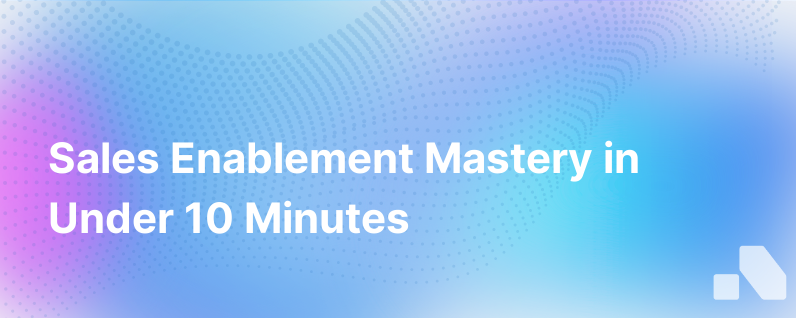
The fast-paced nature of the sales world demands that teams be quick, adaptable, and always equipped with the best tools and strategies if they want to outperform their competitors and meet their targets. Sales enablement serves as the bedrock for empowering sales teams to do just that, providing them with the necessary resources and training to enhance their performance. When time is of the essence — for instance, when you have merely ten minutes to absorb what might usually take two hours — it becomes all about distilling down to the core best practices of sales enablement.
Here, we provide sales leaders and teams with a condensed guide to the fundamental best practices of sales enablement. Apply these strategies, and you can expect to see improved sales efficiency and effectiveness in your team.
Streamline Content Management and Accessibility
The lifeblood of any sales team is the content used for presentations, pitches, and follow-ups. Sales enablement best practices dictate that such content must be:
- Easily Accessible: Sales reps should be able to find the exact content they need when they need it, which means having an organized content repository with intuitive searching capabilities.
- Up-to-Date: Content should reflect the latest product features, pricing, and messaging. Leveraging a system that tracks updates can help keep everything current.
- Customizable: Reps often need to tailor content to the specific needs of a prospect. Templates should be adaptable without sacrificing brand consistency.
Consider adopting content management systems that are integrated with your CRM to streamline the process of organizing and updating sales materials.
Leverage Data-backed Insights for Training
Traditional training and enablement take time — a luxury not always available. Condensing hours of training into actionable insights can be done by leveraging data analytics. Evaluate what has worked in past deals using CRM data analytics, and tailor your training to focus on these proven tactics. Highlight these key points:
- Effective Approaches: What methods have led to successful conversions?
- Common Objections: What issues come up repeatedly, and how have they been successfully navigated?
- Case Studies: Illustrate best practices with real-life examples of deals won by your sales team.
Ensure your reps understand the data behind the strategies to help them make informed, persuasive pitches.
Maximize CRM Optimization
Your Customer Relationship Management (CRM) system is more than a repository for customer data — it's a powerful tool for sales enablement when optimized correctly. In a brief window of time, reps should focus on:
- Integrating Tools: Connect email, call logging, and social media platforms to the CRM to centralize information and actions.
- Automating Processes: Utilize CRM automation for scheduling follow-ups, logging calls, and updating deal statuses to save reps time and ensure nothing falls through the cracks.
- Customizing Views: Tailor dashboards and reports to show the most relevant metrics for performance tracking and decision-making.
Training reps to use CRM efficiently can vastly increase their productivity and ability to engage with clients effectively.
Implement Just-in-Time Learning
In an ideal world, sales reps would have extensive preparation time for client meetings — reality is often quite different. Enter just-in-time learning:
- Microlearning: Condense knowledge into short, focused segments that reps can quickly absorb.
- Mobile Accessibility: Ensure that training materials can be accessed on-the-go from any device.
- Contextual Availability: Use triggers within the sales process that prompt relevant learning materials when they are most needed.
This approach respects the rep's time and hones in on the most critical information at the moment it is required.
Encourage Cross-Functional Collaboration
Sales shouldn't operate in a silo. When time is limited, encourage collaboration across teams:
- Marketing Insights: Quick sync-ups with marketing can help reps understand the latest campaign messaging and collateral available.
- Product Team Data: Updates from product teams should be concise, focusing on the most relevant feature releases or bug fixes.
- Customer Success Stories: Sales can learn much from the success stories and challenges faced by customer success teams.
Cross-functional collaboration ensures sales reps are informed and equipped from various perspectives within the company.
Customize Playbooks for Different Scenarios
No two sales interactions are the same, and playbooks should reflect that diversity:
- Role-based Playbooks: Create different sales playbooks based on the role of the person you're selling to.
- Industry-specific Playbooks: Tailor messages and tactics for different industries.
- Use Case Playbooks: Have playbooks for different common use cases or pain points.
Playbooks should be concise and focused, allowing reps to identify the most fitting strategy quickly.
Regular Coaching and Feedback
Sales coaching doesn't always have to be a lengthy process. Here's how to condense it:
- Peer Reviews: Use short, focused peer-to-peer reviews to provide immediate actionable feedback.
- Sales Metrics Analysis: Quick analysis of key sales metrics can reveal areas for rapid improvement.
- Ride-alongs: Brevity is key; even short sessions joining a rep on a sales call can provide valuable insights and on-the-spot coaching opportunities.
Incorporate these practices into regular workflows for continuous improvement.
Conclusion
When implementing sales enablement strategies, time efficiency does not mean sacrificing depth or quality. By focusing on streamlined content management, data-backed insights, CRM optimization, just-in-time learning, cross-functional collaboration, customized playbooks, and regular bite-sized coaching, sales teams can significantly boost their performance in a fraction of the usual time it takes for enablement activities.
Incorporating a suite of tools that automate and assist in these areas, such as Aomni, can further consolidate the sales enablement process, effectively condensing hours of work into minutes. With these practices in place, sales teams are not just prepared to face the competition — they're equipped to lead the charge.